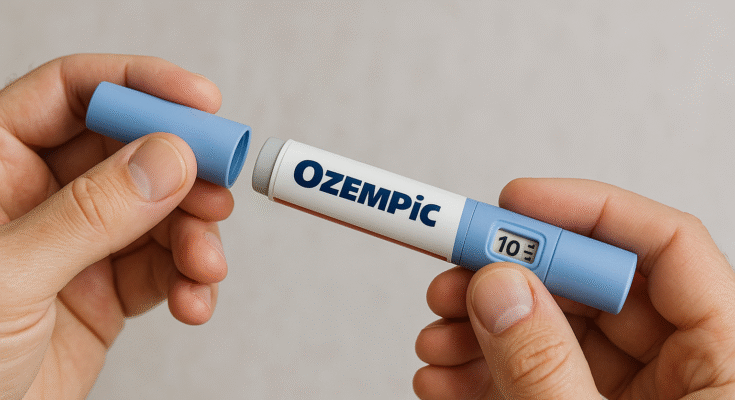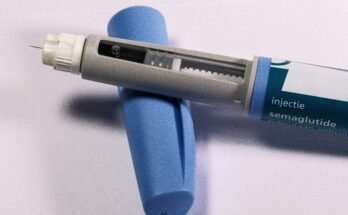If you’re using Ozempic to manage type 2 diabetes or for off-label weight loss, you’ve likely encountered the sleek, pre-filled pen that delivers this game-changing medication. But here’s a question that pops up frequently: How many clicks are in a 1 mg Ozempic pen? Whether you’re a first-timer or a seasoned user trying to fine-tune your dose, understanding the “click” system can feel like cracking a code. Don’t worry—I’m here to break it down with clarity, a dash of enthusiasm, and expert insights to make your Ozempic journey smoother. Let’s dive into the clicks, doses, and everything you need to know to use your pen like a pro.
What Is Ozempic, and Why the Clicks?
Ozempic (semaglutide) is a GLP-1 receptor agonist that helps control blood sugar, reduces cardiovascular risks, and, for many, supports weight loss. It’s administered weekly via a pre-filled, disposable pen that’s designed to be user-friendly. The “clicks” you hear when turning the dose selector are part of the pen’s mechanism to measure out precise doses. Each click represents a tiny increment of medication, and knowing how many clicks correspond to your prescribed dose is key to getting it right.
The 1 mg Ozempic pen is one of three available strengths (alongside 0.25 mg/0.5 mg and 2 mg pens), and it’s typically used for maintenance dosing after you’ve titrated up from the starting 0.25 mg dose. But here’s where things get interesting: some users and healthcare providers use the click-counting method to customize doses, especially to manage side effects like nausea or heartburn. So, how many clicks does it take to deliver 1 mg? Let’s find out.
The Click Count: Breaking Down the 1 mg Ozempic Pen
The 1 mg Ozempic pen contains 4 mg of semaglutide in a 3 mL solution, delivering four weekly doses of 1 mg each. According to reliable sources, including user guides and online discussions, this pen has a total of 74 clicks for the full 4 mg capacity. Here’s how it works:
- 1 mg dose: To deliver a full 1 mg dose, you turn the dose selector until the dose counter shows “1.” This corresponds to 74 clicks from the starting position (or 37 clicks if you’re dialing from the 0.5 mg mark, as some users do for smaller doses).
- Smaller doses: If you’re instructed to administer a dose less than 1 mg (e.g., 0.5 mg), you’d dial to approximately 37 clicks, which aligns with the 0.5 mg mark. For even smaller microdoses, like 0.25 mg, you’d aim for around 18–19 clicks.
These click counts are based on the pen’s design, where each click delivers a small increment of the 1.34 mg/mL semaglutide solution. However, here’s a critical caveat: Novo Nordisk, the manufacturer, explicitly advises against counting clicks for dosing. Why? The click method isn’t officially validated, and dosing inaccuracies could lead to under- or overdosing. Always use the dose counter and pointer to select the marked 1 mg dose for accuracy.
Why Count Clicks? The Real-World Context
You might be wondering, “If counting clicks isn’t recommended, why do people do it?” The answer lies in practical challenges and patient needs:
- Managing Side Effects: Starting Ozempic or increasing the dose can cause gastrointestinal side effects like nausea or heartburn. Some doctors suggest microdosing (e.g., 0.35 mg or 0.5 mg) by counting clicks to ease the transition. For example, 26 clicks might approximate 0.35 mg, though this is off-label and not FDA-approved.
- Medication Shortages: During Ozempic shortages, patients sometimes receive a 1 mg pen when a lower-dose pen isn’t available. Counting clicks allows them to approximate smaller doses (e.g., 0.25 mg or 0.5 mg) to stretch their supply.
- Cost Savings: Ozempic can cost $954–$1,400 monthly without insurance. Some patients use higher-dose pens (like 1 mg or 2 mg) and count clicks to administer smaller doses, reducing the need for frequent refills.
On platforms like Reddit, users share their click-counting experiences: one user noted their doctor recommended “17 clicks for 0.25 mg” to minimize side effects, while another confirmed “74 clicks for 1 mg” on the 1 mg pen. These anecdotes highlight the method’s popularity, but they also underscore the need for medical supervision.
The Risks of Click Counting
While click counting can be tempting, it’s not without risks. Novo Nordisk and the Australian Diabetes Educators Association (ADEA) warn that this method may lead to inconsistent dosing, potentially reducing efficacy or increasing side effects. For example, the pen’s clicks aren’t calibrated for precise microdosing, and human error (like miscounting) can throw things off. There’s also the issue of pen expiration—Ozempic pens are only guaranteed stable for 56 days after first use, so stretching a pen’s use could compromise the medication’s potency.
If you’re considering click counting, always consult your healthcare provider. They can guide you on safe titration and ensure you’re not compromising your treatment.
How to Use the 1 mg Ozempic Pen Correctly
To avoid the uncertainties of click counting, here’s how to use the 1 mg Ozempic pen as intended:
- Check the Pen: Ensure the label reads “Ozempic 1 mg/dose” and the solution is clear and colorless.
- Attach a New Needle: Use a fresh NovoFine Plus needle for each injection to prevent contamination or blockages.
- Prime the Pen: Before the first use of a new pen, check the flow by turning the dose selector to the flow-check symbol and pressing the dose button until a drop appears.
- Select the Dose: Turn the dose selector until the counter shows “1” (for 1 mg). Do not count clicks—rely on the dose counter and pointer.
- Inject: Choose a site (abdomen, thigh, or upper arm), clean it with an alcohol swab, insert the needle, and press the dose button until the counter returns to “0.” Hold for 6 seconds to ensure the full dose is delivered.
- Dispose Safely: Place the used needle and empty pen in an FDA-approved sharps container.
Each 1 mg pen delivers four 1 mg doses, lasting one month at the prescribed dose. If the dose counter stops before “1,” the pen doesn’t have enough medication for a full dose—time to grab a new one.
Tips for a Smooth Ozempic Experience
- Rotate Injection Sites: Alternate between the abdomen, thigh, and upper arm to prevent skin irritation.
- Store Properly: Keep unused pens in the fridge (36–46°F) and used pens at room temperature (up to 86°F) for up to 56 days.
- Track Doses: Use the table inside the pen’s carton to log your injections.
- Manage Side Effects: If you experience nausea or heartburn, talk to your doctor about dose adjustments or dietary changes (e.g., avoiding spicy foods).
Final Thoughts
The 1 mg Ozempic pen delivers four weekly 1 mg doses, with 74 clicks corresponding to the full 1 mg dose. While counting clicks can be a workaround for microdosing or managing shortages, it’s not the gold standard—stick to the dose counter for precision and safety. By following your doctor’s guidance, using the pen correctly, and keeping an eye on side effects, you can make the most of Ozempic’s benefits. Got questions or hitting a snag? Your healthcare provider is your best ally. Here’s to taking control of your health, one click (or dose) at a time!
FAQs
1. Can I use the 1 mg Ozempic pen to deliver a 0.5 mg dose?
Yes, you can dial to 0.5 mg (approximately 37 clicks), but only under your doctor’s guidance. The pen is designed for 1 mg doses, so rely on the dose counter, not clicks, for accuracy.
2. How do I know if my 1 mg Ozempic pen is empty?
If the dose counter stops before reaching “1,” there’s not enough medication for a full 1 mg dose. Check the pen window—if no liquid is visible or the selector won’t turn, it’s time for a new pen.
3. Is it safe to count clicks for Ozempic dosing?
Counting clicks is not recommended by the manufacturer due to potential dosing inaccuracies. Always use the dose counter and consult your doctor for any dose adjustments.

Jake Morrison is a health journalist and certified medical researcher who specializes in obesity treatment and diabetes care. With a background in biomedical science and years spent analyzing real-world outcomes of GLP-1 therapies like Ozempic, Jake brings an evidence-driven, reader-friendly approach to complex medical topics.




